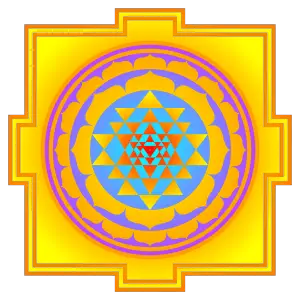Yantra
- For other uses, see Yantra (disambiguation).
Yantra is a Sanskrit word that is derived from the root meaning "to restrain, curb, check".[1][2] Meanings for the noun derived from this root include "that which restrains or fastens, any prop or support", "a fetter", "any instrument or machine", "an amulet, a mystical or astronomical diagram used as an amulet."[3][4]
Some Hindu esoteric practitioners employ yantra, mantra and other items in their sadhana, puja and yajna.[5]
Yantra, or other permutations and cognate phenomena such as Mandala, Rangoli, Kolam, Rangavalli and other sacred geometrical traditions, are endemic throughout Dharmic Traditions.
Yantra as astronomical map
Yantra is basically a diagram representing the astronomical position of the planets over a given date and time. It is considered auspicious in Hindu mythology. These yantras are made up on various objects i.e. Paper, Precious stones, Metal Plates and alloys. It is believed that if we, as humans, follow the basic principal of constantly concentrating on the representation, it helps you build Fortunes, as planets above have their peculiar Gravity which governs basic emotions and karma, derived to attain satisfaction. These yantras are basically made on a particular date and time depending on the prescribed procedures defined under vedas.
Yantra as portal of communion
Yantra in Sanskrit denotes "loom", "instrument" and "machine". Yantra is an aniconic temenos or tabernacle of deva, asura, genius loci or other archetypal entity. Yantra are theurgical device that engender entelecheia. Yantra are realised by sadhu through darshana and samyama. There are numerous yantra. Shri Yantra is often furnished as an example. Yantra contain geometric items and archetypal shapes and patterns namely squares, triangles, circles and floral patterns; but may also include bija mantra and more complex and detailed symbols. Bindu is central, core and instrumental to yantra. Yantra function as revelatory conduits of cosmic truths. Yantra, as instrument and spiritual technology, may be appropriately envisioned as prototypical and esoteric concept mapping machines or conceptual looms. Certain yantra are held to embody the energetic signatures of, for example, the Universe, consciousness, ishta-devata. Some Hindu esoteric practitioners employ yantra, mantra and other items of the saṃdhyā-bhāṣā (Bucknell, et. al.; 1986: p.ix) in their sadhana, puja and yajna. Though often rendered in two dimensions through art, yantra are conceived and conceptualised by practitioners as multi-dimensional sacred architecture and in this quality are identical with their correlate the mandala. Meditation and trance induction with Yantra are invested in the various lineages of their transmission as instruments that potentiate the accretion and manifestation of siddhi.
Khanna (2003: p.21) in linking Mantra, Yantra, Ishta-devata, and thoughtforms states:
Mantras, the Sanskrit syllables inscribed on yantras, are essentially 'thought forms' representing divinities or cosmic powers, which exert their influence by means of sound-vibrations.[6]
See also
- Mandala
- Namkha
- Sigil
- Tantra
Notes
- ↑ For root यन्त्र् (yantr) meaning "to restrain, curb, check" see: Apte 1965, p. 781.
- ↑ For definition: "A yantra (from the root yam) is that which controls or subdues." see: White 1996, p. 481, note 159.
- ↑ For definitions for noun यन्त्रं (yantraṃ) including 1) "that which restrains or fastens, any prop or support"; 2) "a fetter", 4) "any instrument or machine", and 7) "an amulet, a mystical or astronomical diagram used as an amulet"; see: Apte 1965, p. 781.
- ↑ For definitions for यन्त्रं (yantra) including "any instrument for holding, restraining, or fastening, a prop, support, barrier"; "any instrument or apparatus, mechanical contrivance, engine, machine, implement, appliance"; "restraint, force"; "an amulet, mystical diagram supposed to possess occult powers", see: Monier-Williams 1899, p. 845.
- ↑ Bucknell, et al.; 1986: p. ix.
- ↑ Khanna, Madhu (2003). Yantra: The Tantric Symbol of Cosmic Unity. Inner Traditions. ISBN-10: 0892811323 & ISBN-13: 978-0892811328
ReferencesISBN links support NWE through referral fees
- Khanna, Madhu (2003). Yantra: The Tantric Symbol of Cosmic Unity. Inner Traditions. ISBN-10: 0892811323 & ISBN-13: 978-0892811328
- Apte, Vaman Shivram (1965), The Practical Sanskrit Dictionary (Fourth revised and enlarged ed.), Delhi: Motilal Banarsidass Publishers, ISBN 81-208-0567-4
- Bucknell, Roderick & Martin Stuart-Fox (1986), ''The Twilight Language: Explorations in Buddhist Meditation and Symbolism, London: Curzon press, ISBN 0-312-82540-4
- Monier-Williams, Monier (1899), A Sanskrit-English Dictionary, Delhi: Motilal Banarsidass
- White, David Gordon (1996), The Alchemical Body: Siddha Traditions in Medieval India, The University of Chicago Press, ISBN 0-226-89499-1
Credits
New World Encyclopedia writers and editors rewrote and completed the Wikipedia article in accordance with New World Encyclopedia standards. This article abides by terms of the Creative Commons CC-by-sa 3.0 License (CC-by-sa), which may be used and disseminated with proper attribution. Credit is due under the terms of this license that can reference both the New World Encyclopedia contributors and the selfless volunteer contributors of the Wikimedia Foundation. To cite this article click here for a list of acceptable citing formats.The history of earlier contributions by wikipedians is accessible to researchers here:
The history of this article since it was imported to New World Encyclopedia:
Note: Some restrictions may apply to use of individual images which are separately licensed.
